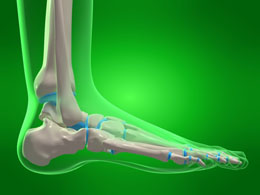If Sachin Tendukar gets the credit for making the 'tennis elbow' injury famous, then it is David Beckham who gets the honors when it comes to the metatarsal injury. Read the following article to acquaint yourself about the first metatarsal bone fracture and its treatment.

The famed soccer star suffered from the metatarsal injury just before the 2002 Football World Cup, making his participation doubtful. Although he suffered from a fracture of the 2
nd metatarsal, the 1
st metatarsal fracture is considered to be one of the very common injuries.
Structure and Function
➜ The foot is considered to be very complex when it comes to its structure. It consists of muscles, bones, tendons, and a few other soft tissues. Calcaneus, Talus, Navicular, Medial Cuneiform, Intermediate Cuneiform, Lateral Cuneiform, Cuboid, and Metatarsus are the various foot bones.
➜ Metatarsus consists of 5 bones known as the metatarsal bones which form the middle part of the foot. These bones are numbered from 1 to 5 starting from the big toe. The 1
st metatarsal bone starts at the base of the big toe.
➜ Compared to the other metatarsal bones, the 1
st bone is shorter. Comparatively, it has a stronger body structure than the others. The structure of the bone can be divided into 3 parts - the base, the head region, and the shaft, all of them being surrounded by a shell of cortical bone.
➜ The body is slightly curved vertically making the shape of the bone concave from below and a little convex from the top. This angle is oval in shape and rough, which enables the insertion of the peronaeus longus tendon.
➜ There are 2 sesamoid bones on the head of the 1
st metatarsal, enabling it to bear almost a third of the body weight. The absence of ligaments between the 1
st and 2
nd metatarsal bones makes independent movements possible.
➜ The important biomechanical function of load bearing makes the 1
st metatarsal susceptible to injury. It can occur in the form of fractures.
What is a 1st Metatarsal Fracture?
➜ There are various ways in which one can fracture the 1
st metatarsal. Since it is already under constant stress, a substantial increase in stress on the foot could cause a fracture. Twisting of the foot badly can also lead to a fracture. It is therefore common in soccer players, athletes, ballet dancers, and military recruits.
➜ Another factor causing this type of fracture would be the case of something heavy falling on one's foot. This could seriously displace or even crush the 1
st metatarsal bone leading to a subsequent fracture. At times, a fracture of the first metatarsal bone can also lead to arthritis, making it difficult even to walk.
Treatment for the Fracture
➜ The treatment varies depending upon the extent to which the bone is hurt or damaged. It mostly is a stress fracture. To determine this one needs to take the help of X-rays first.
➜ The X-ray also helps to determine whether or not there is a need for an operation. If the bone is slightly displaced or is showing minimum damage, then one can opt for either a removable boot or a cast made of plaster of Paris (POP). This should be worn for around 4 - 6 weeks depending upon the extent of injury.
➜ A modern-day option for this is a removable Aircast boot, albeit a little expensive compared to the other alternatives. In case of a serious fracture, one needs to get it operated. This takes place when the 1
st metatarsal bone is dislocated from its head. The operative treatment for this could be an internal fixation of the bones with the help of screws, K-wire fixation, or ORIF. For very severe fractures, even an external fixation could be used.
Such injuries, though not very common among normal working people, should not be taken lightly. Metatarsal injuries do not need to be operated most of the time, but proper care must be taken to ensure that the injury is not further aggravated. As is the case with any injury, it is best to consult a doctor for proper diagnosis and treatment.
Disclaimer: This Buzzle article is for informative purposes only and should not be used as a replacement for expert medical advice.


 The famed soccer star suffered from the metatarsal injury just before the 2002 Football World Cup, making his participation doubtful. Although he suffered from a fracture of the 2nd metatarsal, the 1st metatarsal fracture is considered to be one of the very common injuries.
The famed soccer star suffered from the metatarsal injury just before the 2002 Football World Cup, making his participation doubtful. Although he suffered from a fracture of the 2nd metatarsal, the 1st metatarsal fracture is considered to be one of the very common injuries.